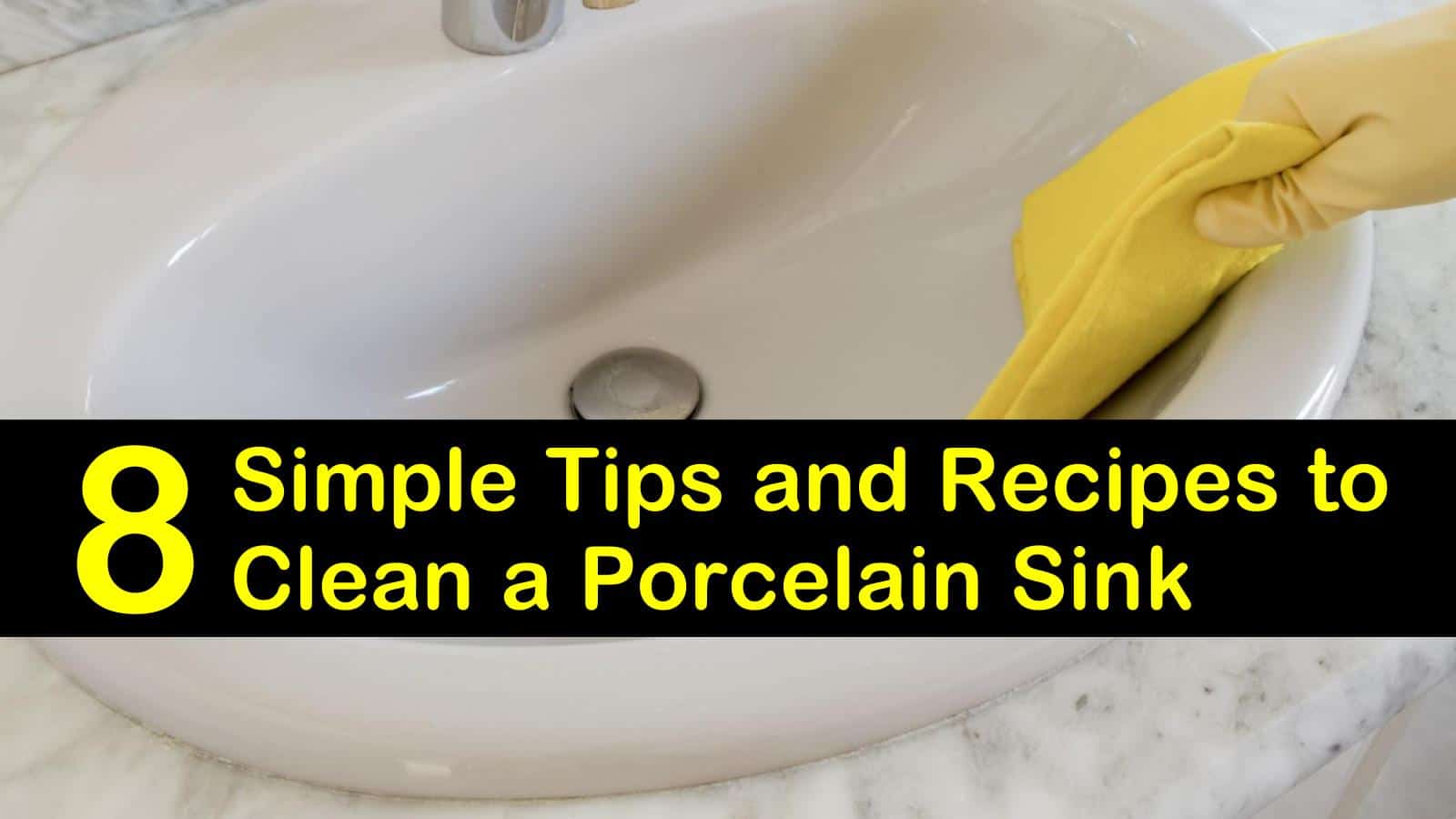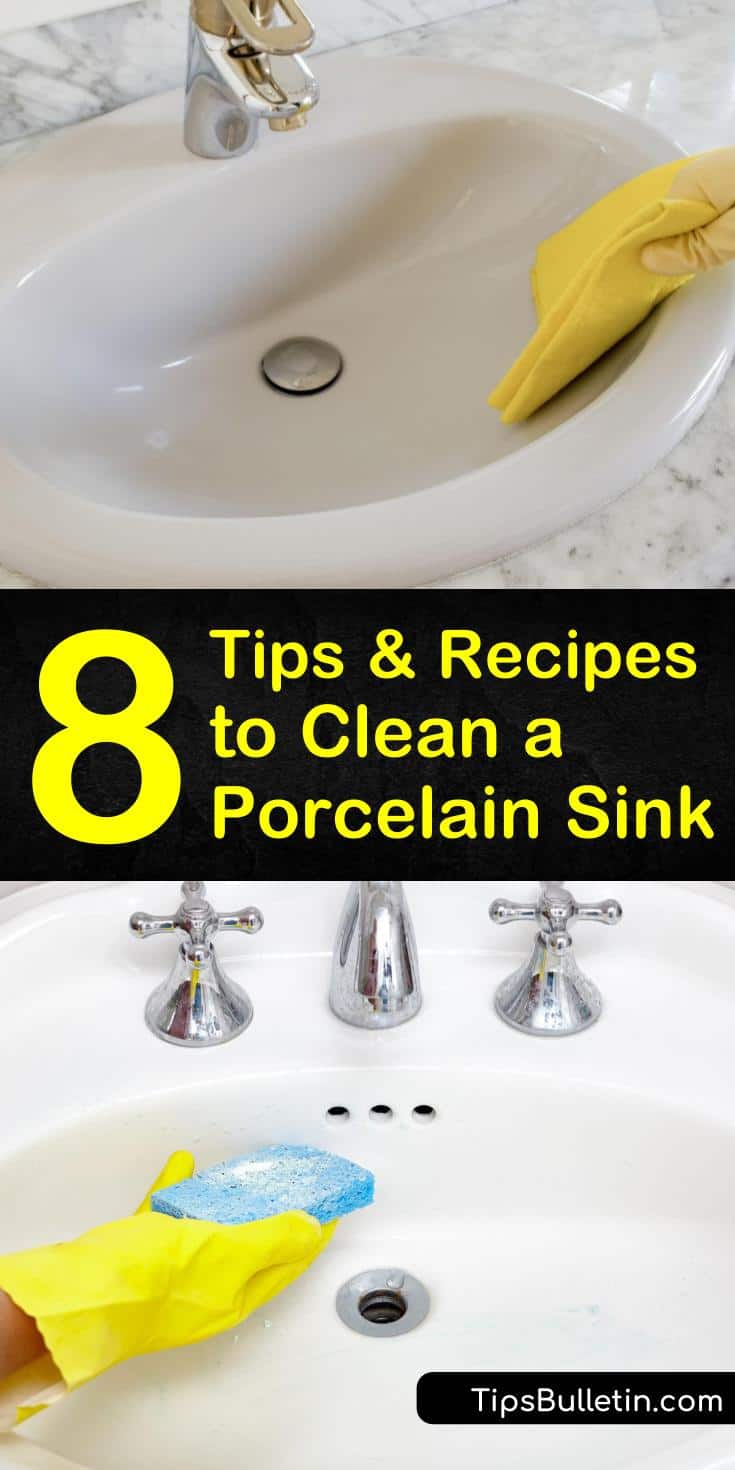Over time, your porcelain sink not only starts showing stains, but it also begins to lose some of its shine. If that does happen, you need to learn how to clean a porcelain sink correctly to restore your sink’s shine. A sparkling clean porcelain sink not only adds a sense of cleanliness and a certain amount of charm to your home, but it also adds to your home’s overall value.
Many people assume that cleaning a white porcelain sink is easy as its non-porous surface repels against most stains. While this style of sink is non-porous, due to daily wear and tear, the glaze on the porcelain loses its shine and its ability to repel stains. In bathrooms, they lose their shine due to soap scum and hard water stains.
Rust and cosmetics are also a potential problem in a porcelain bathroom sink. For the kitchen, porcelain sinks food stains are the most common issue, but silverware and other dishes leave behind scuff marks and can even score the basin’s surface. To keep yours looking like new, learn how to restore shine to porcelain sink.

- Useful Tips for Cleaning a White Porcelain Sink
- Best Tip for How to Clean a Porcelain Sink
- Cleaning Your Sink with Vinegar
- Cleaning a White Porcelain Sink with Bleach
- Removing Deep Stains with a Mild Abrasive
- Remove Silverware and Other Metal Stains
- Tips for How to Restore Shine to Porcelain Sink
- Polishing Up Your Porcelain Sink
- When It’s Time to Re-Glaze Your Sink
Useful Tips for Cleaning a White Porcelain Sink
If you notice your basin is losing its shine or is beginning to show stains, despite trying to prevent them, there are several techniques to use to clean up your sinks.
What method you try depends on the severity of staining or scuffing, as technique and product effectiveness vary. Colored porcelain or antique sinks require nonabrasive cleaning products and no bleach, while white ones don’t.
Best Tip for How to Clean a Porcelain Sink
For a colored, antique, or white porcelain kitchen sink, the one thing to keep in mind is never using cleaners that scratch glass. Always use a nonabrasive sponge or a soft cloth for cleaning to prevent scratching the glaze. When cleaning your Kohler bathroom or kitchen sink, use a circular motion and wipe down the faucet, so your entire sink looks clean.
This method is the best one to use when you are trying to speed-clean your bathroom. Use a sponge or a soft rag, some warm water, and a squirt of liquid dishwashing soap to clean both white and colored basins. Scrub gently with the nonabrasive cleanser to remove the build-up of food, toothpaste, dish soap, and anything else you find in your sink.

Rinse soap residue away and dry the basin with a clean dish towel. Once cleaned, determine if your sink requires a more in-depth cleaning to remove any stains or scuff marks.
Cleaning Your Sink with Vinegar
Watermarks are one of the most troublesome stains we face in bathroom sinks. Cleaning a sink with white vinegar is the best way to tackle that problem. To remove these unsightly stains from your porcelain, close the sink’s drain and fill with hot water.
Add two cups of vinegar and leave alone to soak for four hours. Drain the water and vinegar from the basin, wipe any leftover marks with a sponge, and then rinse thoroughly.
Failure to rinse away the vinegar may damage your sink’s finish, as vinegar is highly acidic.
Cleaning a White Porcelain Sink with Bleach
Always start cleaning your porcelain with the least abrasive option, as too much scrubbing combined with abrasive cleaners can cause irreversible damage. Only use bleach on white porcelain to remove any discoloration. For a vintage or colored porcelain enamel replace bleach with hydrogen peroxide.
Use liquid oxygen bleach as an alternative to get stains off a ceramic sink in the bathroom, although it may take longer to achieve your desired results. Pour either the hydrogen peroxide or chlorine bleach into a clean spray bottle. Cover the bowl of your sink with a layer of paper towels.
Spray paper towels generously with hydrogen peroxide or bleach. Allow everything to sit for up to one hour, and remove and discard paper towels. Rinse thoroughly with clean water. We suggest adding this idea to your printable bathroom cleaning checklist.
Removing Deep Stains with a Mild Abrasive
If you don’t want to use bleach for cleaning stained porcelain, use a mild abrasive to remove those deeper stains that haven’t responded to vinegar or dish soap. Pay close attention to what abrasive you are using, as not all mild abrasives are safe to use on porcelain.
Mild abrasives such as Borax, Soft Scrub, and Bar Keepers Friend are safe for porcelain and work to remove deep stains. Stay away from Comet and other more abrasive cleaners, as well as Magic Erasers and other acidic cleaners, as they can dull the finish.
To use, squirt a small amount of cleaner for porcelain directly into the sink and scrub gently at the discoloration with a nonabrasive sponge. Bar Keepers Friend contains oxalic acid to remove stains and is quite effective but use it sparingly to keep from damaging the porcelain.
Cleaning with these seemingly safe products too often causes discoloration and scratching to the porcelain surface. Mild abrasive cleaners are safe for use on stainless steel; use them to wipe down your sink or dishwasher and other kitchen appliances.
Remove Silverware and Other Metal Stains
Silverware stains are common in kitchen porcelain sinks, as well as reddish-orange rust stains. To remove these metal stains, use either a few drops of lemon juice or white vinegar. Do not use both, and if switching between the two, be sure to rinse away the first acid before applying the second thoroughly.
Allow the vinegar or lemon juice to sit on the stain for a few minutes, once the stain is gone, rinse with water, and enjoy your stainless sink. Naval jelly is also effective on rust stains. Apply a thin layer to the stains and observe.
As soon as the stain starts to change color, rinse the product away with water. Use naval jelly with extreme caution as it is strong enough to remove rust from metal.
Tips for How to Restore Shine to Porcelain Sink
Nobody has to settle for a dull-looking sink. There are numerous commercial cleaning products to use to restore the shine to your porcelain sinks, but there are also natural cleaners that are just as effective.
Begin by wiping down your sink with undiluted vinegar and a sponge to remove all grime and build-up. Rinse the sink thoroughly and then sprinkle generously with baking soda directly in the sink and on your sponge.
Use some elbow grease and scrub your sink well with the sponge. Rinse thoroughly. Pour hydrogen peroxide over the sponge until it is soaking. Your best bet is to pour the hydrogen peroxide over the sponge while holding the sponge over the sink.
Scrub the entire basin with the sponge and then let sit for 15 minutes before rinsing. Cut a lemon in half and coat it with salt. Scrub the sink again with the salt coated lemon to remove the deeper stains the other cleaning left behind. Rinse thoroughly and dry with a dishtowel or clean rag.
Polishing Up Your Porcelain Sink
After cleaning, you might notice your porcelain is lacking in terms of shine. One way to polish your porcelain is to use car wax. Polishing with car wax not only restores the shine but also prevents future scratches. Apply a dab car wax to a sponge and coat the bowl.
Baby oil or lemon oil also works to restore the shine of your porcelain. When using either oil, apply a few drops onto a clean rag and wipe down the entire sink. The oil restores shine and helps protect against future stains as it forms a protective barrier on your sink, making it harder for things to stick to it.
When It’s Time to Re-Glaze Your Sink
Despite your best efforts at cleaning porcelain sinks, everyday wear and tear are going to take hold. Occasionally, your porcelain sink requires a re-glaze. Re-glazing is not hard and can often be done at home with a commercial re-glazing kit.
If using a kit, follow the instructions provided. Re-glazing kits are also sold as tile polishing as they are used to polish porcelain tiles.
Porcelain sinks are made by bonding the porcelain enamel to a cast-iron fixture, but not everybody is confident enough to do home improvement projects on their own. Sometimes sinks, tubs, and other porcelain fixtures are so stained or scratched getting them clean is impossible.
In these extreme cases, your best bet is to hire a professional to come and do the re-glazing. Although more expensive than doing it on your own, you know the job is being done right. Plus, the cost is worth it, as the re-glazing protects your sink for many years.

Thank you for reading about cleaning a white porcelain sink. If you found our ideas for how to restore shine to porcelain sink or how to clean them helpful, please take the time to share these porcelain cleaning tips on Facebook and Pinterest so other people can learn how to clean a porcelain sink correctly, too.